Shangri La Botanical Gardens, a garden fairy tale
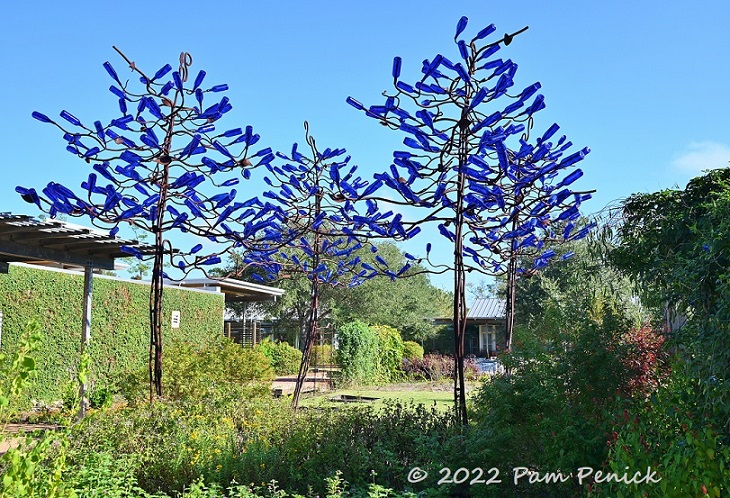
Sleeping Beauty has nothing on Shangri La Botanical Gardens & Nature Center. Located in the small town of Orange, Texas, just across the Sabine River from Louisiana, Shangri La’s very existence is in some ways as fantastical as the fairy tale about a princess hexed into a 100-year sleep and reawakened by a kiss.
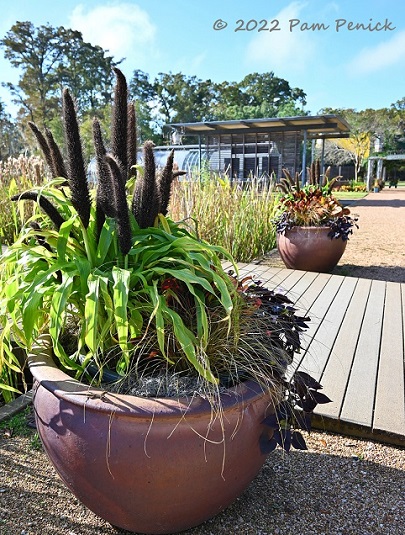
A romantic vision first brought the garden to life. In 1937, Orange native H.J. Lutcher Stark, heir to a Texas timber fortune, began making “his own haven of indescribable beauty where time would stand still” along Adams Bayou. For 9 years Stark worked on his gardens, eventually opening his personal eden to the public. By the early 1950s, thousands of people visited the gardens each spring to see his colorful azaleas in bloom.
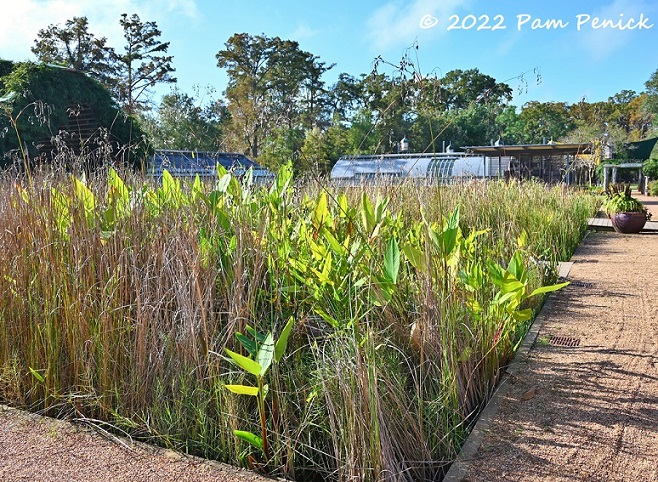
A freak snowstorm blanketed subtropical Zone 9 Orange in the late ’50s. Stark’s garden froze badly, and apparently so did his gardening spirit. He closed Shangri-La to the public, and it lay nearly dormant for 50 years.
After Stark’s death in 1965, his wife, Nelda, bequeathed the property to the Nelda C. and H. J. Lutcher Stark Foundation, which still holds it and finances the garden — handsomely, I assume, since the 250-acre gardens and natural areas are well maintained and admission is free. Five decades after that devastating winter storm, the Stark Foundation began planning the garden’s reawakening. It declared that Shangri La should be the “greenest project in Texas” and hired Lake Flato Architects, MESA Design Group, and Carbo Landscape Architecture to reinvent the gardens, adding a nature center focusing on the wetlands and bayou.
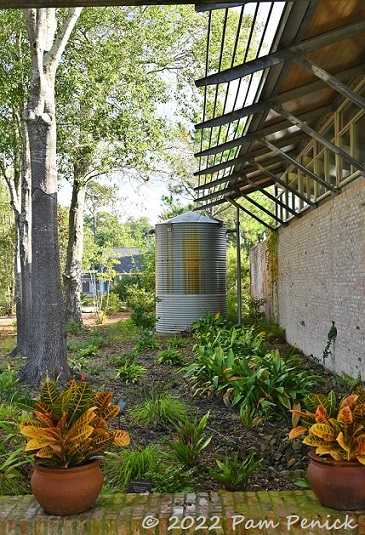
Just as construction began in 2005, Hurricane Rita slammed into Orange, “level[ing] much of Shangri La’s upland forests and historic garden areas…resulting in the loss of more than 50,000 trees.” The design teams forged on and took advantage of fallen trees by incorporating them into the garden’s new structures. The new Shangri La triumphantly opened in March 2008. Six months later, Hurricane Ike inundated the gardens with saltwater, destroying many plants. Shangri La managed to reopen the following spring, when it also received Platinum LEED certification, the highest ranking for green construction.
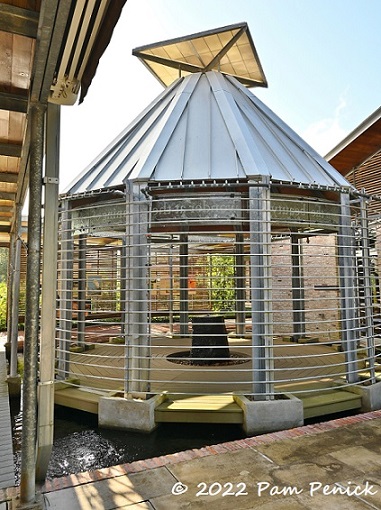
The hurricanes keep coming, however. In 2017 Harvey flooded the gardens with 2 to 3 feet of rainwater and damaged buildings so badly that Shangri La closed for a year for repairs. But the gardens and staff are amazingly resilient. Shangri La today is a place of beauty with ornamental gardens, native plants, wetland gardens, a nature center for school groups, and a large bird blind for viewing anhingas, cormorants, spoonbills, egrets, herons, and other waterbirds. It’s a remarkable resource for southeast Texas and southwest Louisiana.
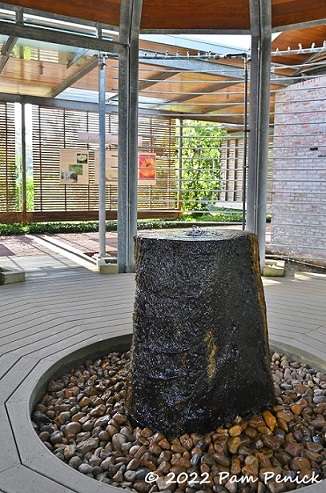
I’d heard about Shangri La for years, but Orange is 4-1/2 hours east of Austin — about halfway to New Orleans. Although we’ve driven to NOLA several times, we’d never stopped in Orange. But in early November we did, adding a day to our road trip home from Asheville so we could visit the garden.
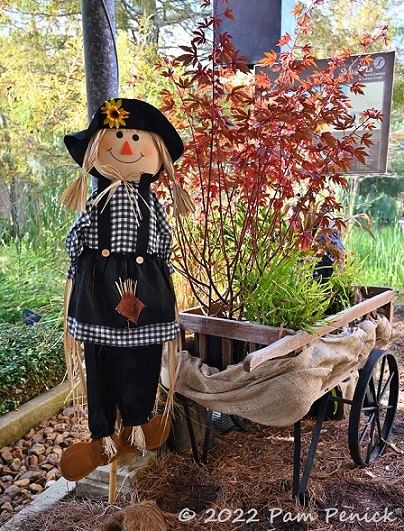
Jennifer Buckner, Shangri La’s director of horticulture, generously took time out of her busy day to give us a guided tour. The fall Scarecrow Festival had just ended, and volunteers were dismantling scarecrow displays. I took pics of a few of them throughout the gardens (coming up in Part 2).
Visitor Center Courtyard
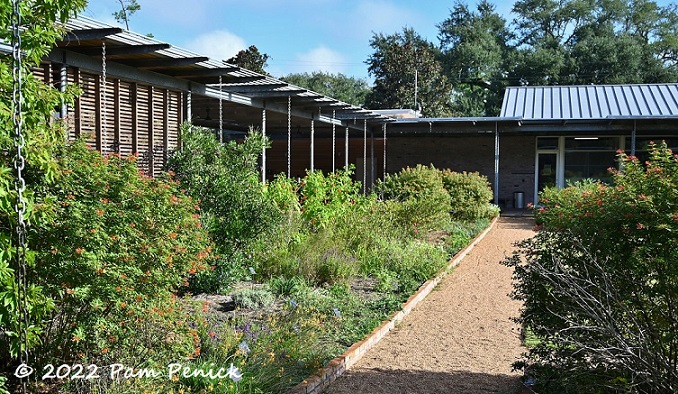
Enough of Shangri La’s history, undaunted though it is. Let’s tour! The Visitor Center buildings wrap around a sunny courtyard with deep perennial beds. The low buildings have that distinctive Lake Flato look — rustic contemporary, with generous shaded breezeways and rain chains to direct rainwater off the roof.
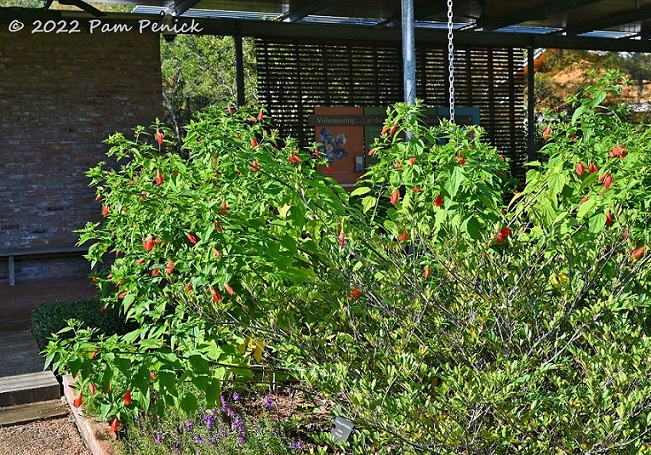
This giant Turk’s cap (Malvaviscus penduliflorus), a sprawling species with dangling, chunky red flowers, caught my eye. Can it grow in Austin, I wonder?
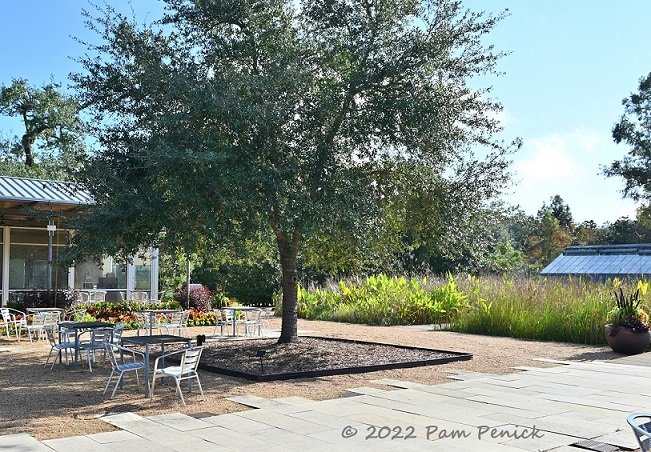
A gravel courtyard with cafe seating takes advantage of a young live oak’s shade and overlooks the unique Wetland Demonstration Garden, which I’ll come back to.
Children’s Garden
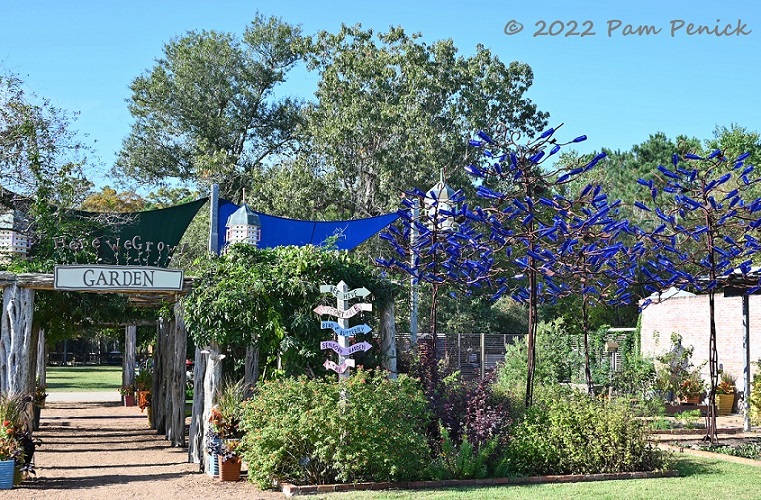
Let’s explore the Children’s Garden. A cedar arbor marks the entrance, but a grove of whimsical bottle trees is what you notice first.
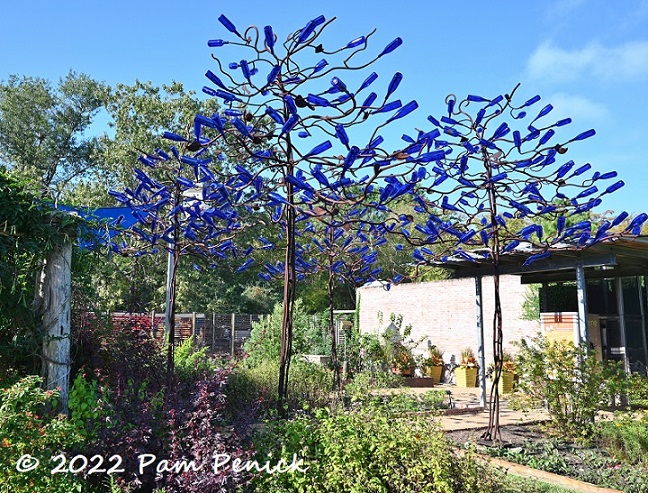
Dancing Sisters by artist Stephanie Dwyer is made of 4 steel trees with 400 light-catching cobalt bottles for leaves. It replaced the garden’s original bottle trees made of reclaimed red cedar, which deteriorated in the heat and humidity after only a few years.
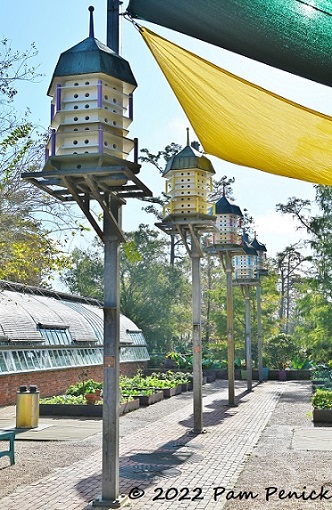
Purple martin houses march through the children’s vegetable garden. Colorful sails add shade, essential in any Texas garden.
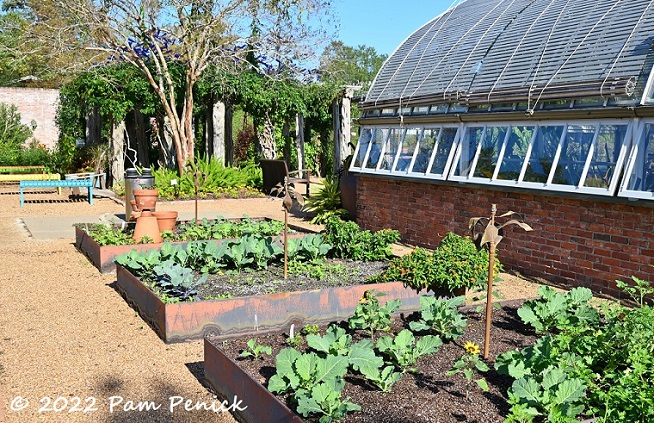
The vegetable garden
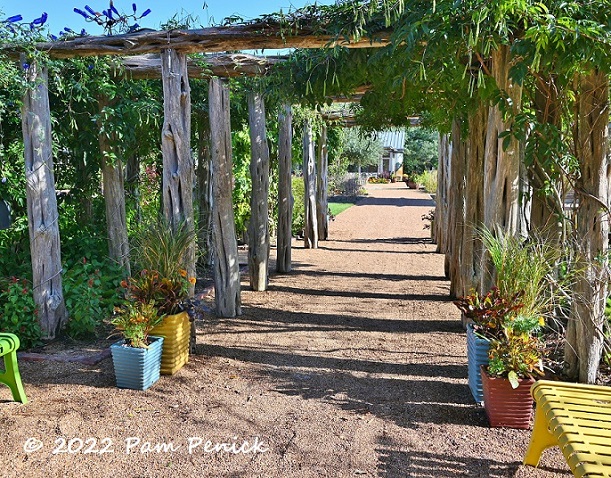
Long cedar arbors draped with vines provide more shade…
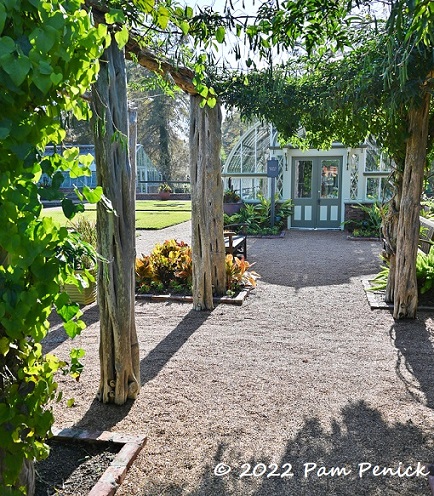
…and frame views.
Greenhouses
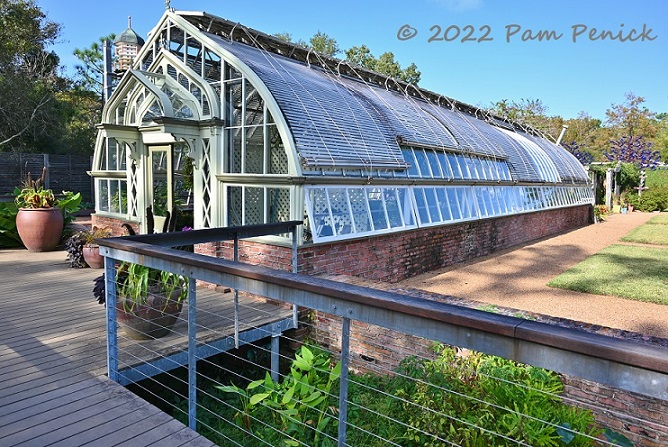
A handsome 1917 Lord and Burnham greenhouse holds the garden’s epiphyte collection.
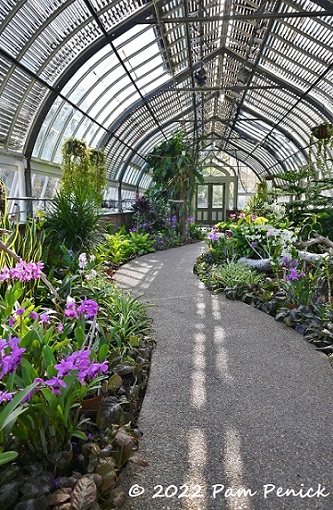
Inside, a serpentine path leads you through orchids and bromeliads, mosses and ferns.
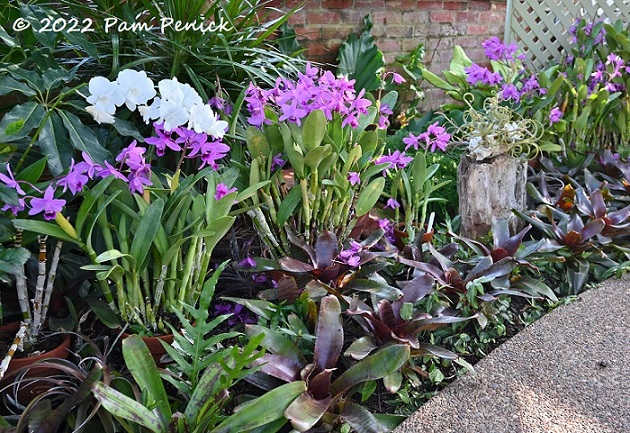
Purple and white orchids frame a border of eggplant-hued bromeliads.
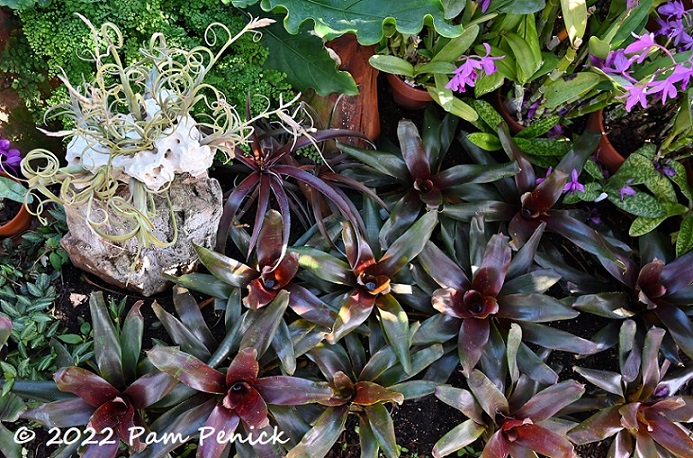
I love these curly tillandsias spiraling out of a holey rock.
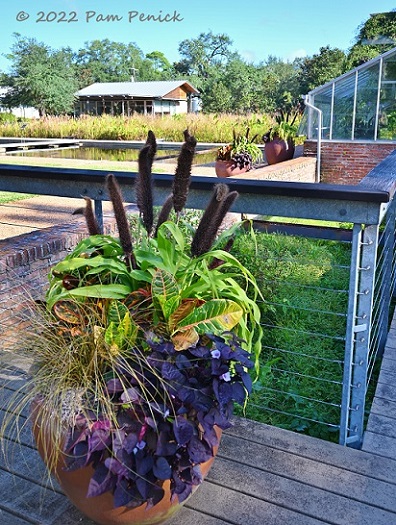
Outside, between greenhouses, autumnal containers accent the boardwalk.
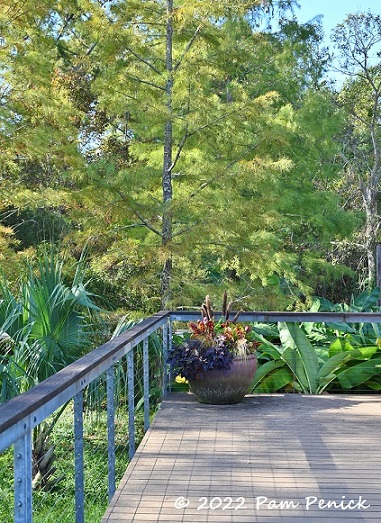
One more
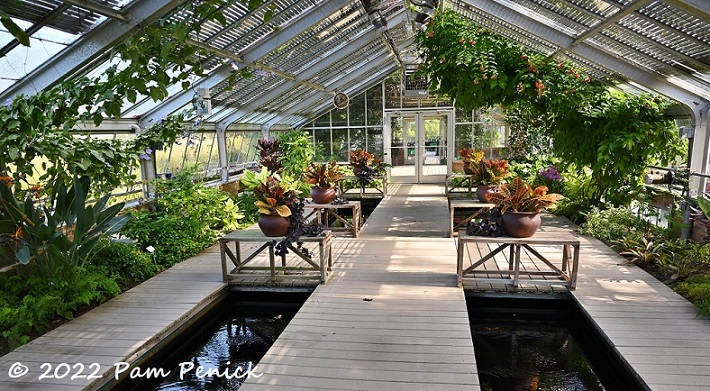
There are also two exhibition greenhouses, one that serves as a classroom and this one for displaying tropicals. The pools help moderate temperatures inside the greenhouse.
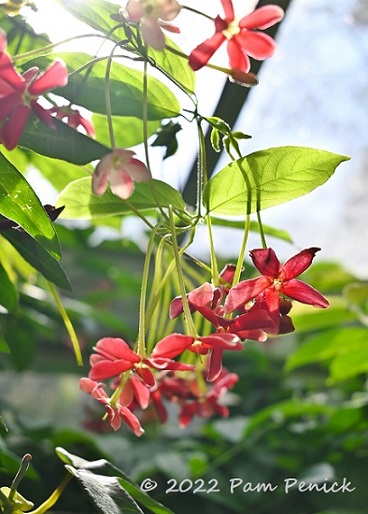
Rangoon creeper (Combretum indicum)
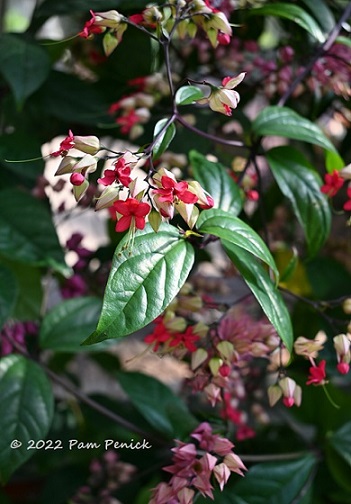
Bleeding heart vine (Clerodendrum thomsoniae)
Wetland Demonstration Garden
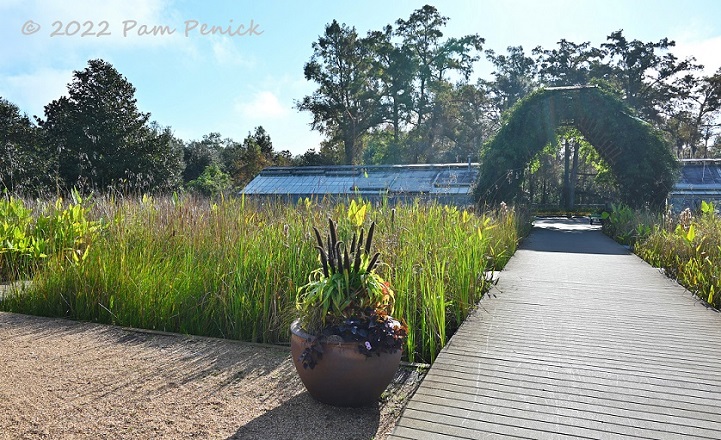
The most unique feature at Shangri La may be the Wetland Demonstration Garden. A series of rectangular ponds filled with native wetland plants makes up a biofiltration system that cleans nearby Ruby Pond.
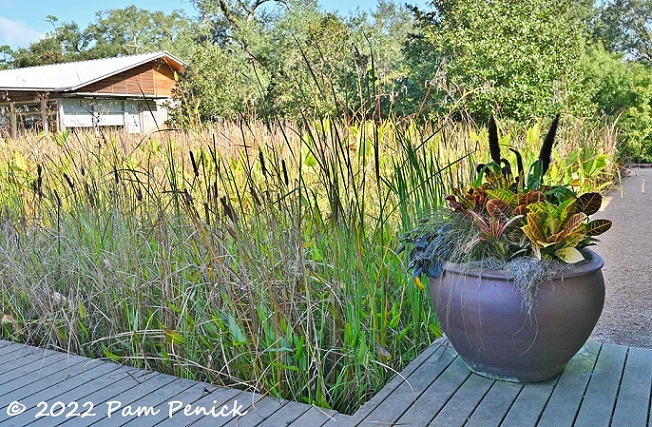
Thousands of nesting birds in Ruby Pond create a lot of bird poop, and the pond became polluted. So ditches were dug from the lake to the wetland garden to circulate dirty lake water through the plants.
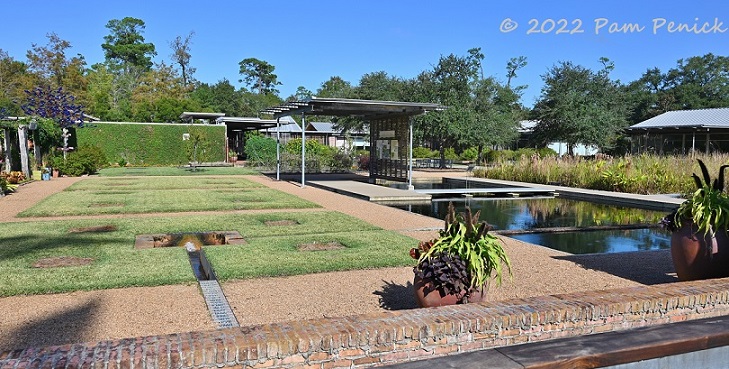
“Plants naturally growing in freshwater wetlands,” according to the garden’s website, “have the remarkable ability to remove pollutants in animal and human waste as well as trap and absorb chemical pollutants and toxic metals. Once water has been filtered by native plants, it is once again clean enough to support wildlife…As the water flows through the first three ponds, plants filter out pollutants from bird excrement and allow suspended materials to settle. In the last pond in this garden, extra oxygen is pumped into the water. Then the water is returned to Ruby Lake.”
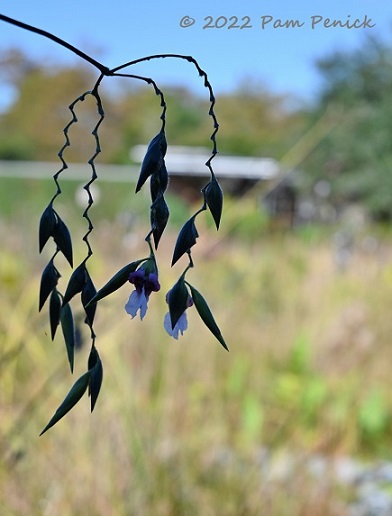
Pretty cool! So is the dangling, rick-rack flower of water canna, aka alligator flag (Thalia geniculata), one of the wetland plants.
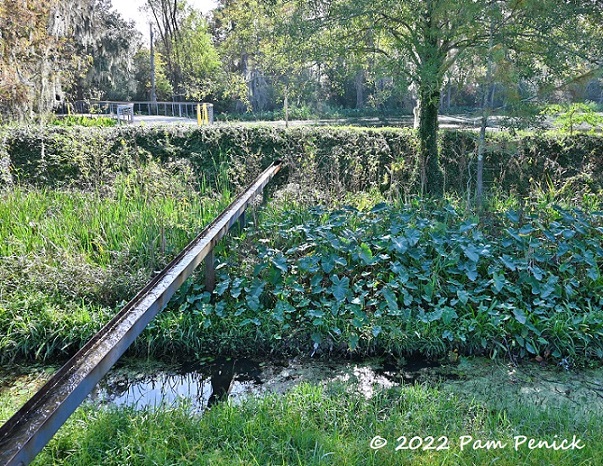
A steel runnel transports recirculating water from the wetland garden to the pond.
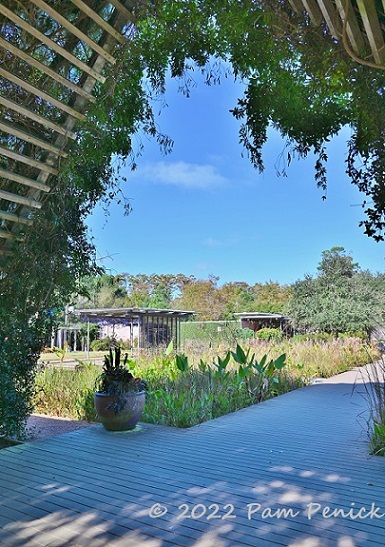
A slatted, vine-covered arch marks the transition from the wetland garden to the main gardens.
Tree Ring Plaza
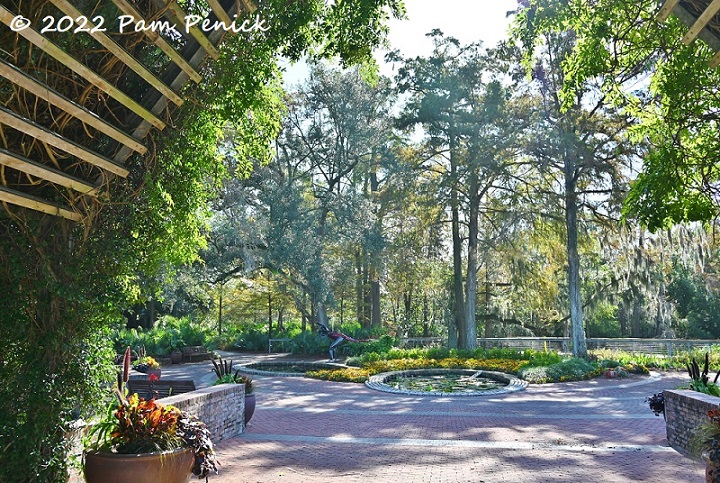
You emerge through the arch into Tree Ring Plaza, where lighter-colored paving strips evoke the growth rings of a tree. A pair of oval waterlily ponds, framed by towering bald cypresses hung with streamers of Spanish moss, draws you forward.
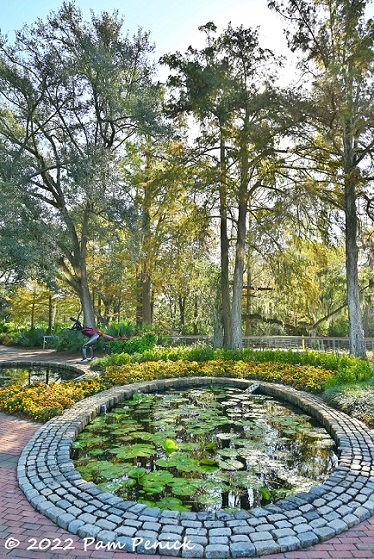
The two ponds were built in 1955 for Stark’s original garden. The cobblestones edging them are from Dunkirk, France, and were used as ballast for ships bound for the U.S.
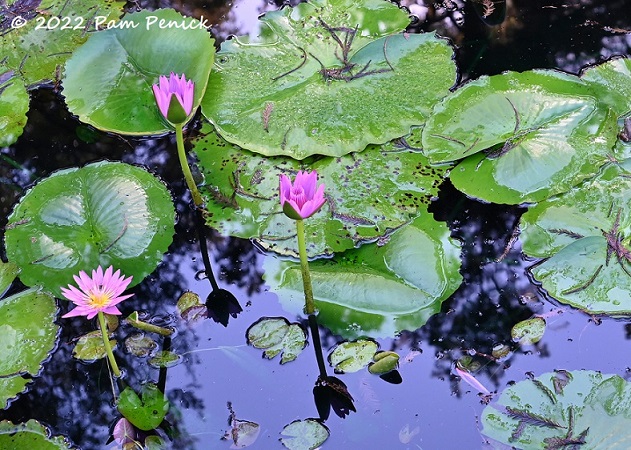
Waterlilies still blooming in early November
Ruby Lake
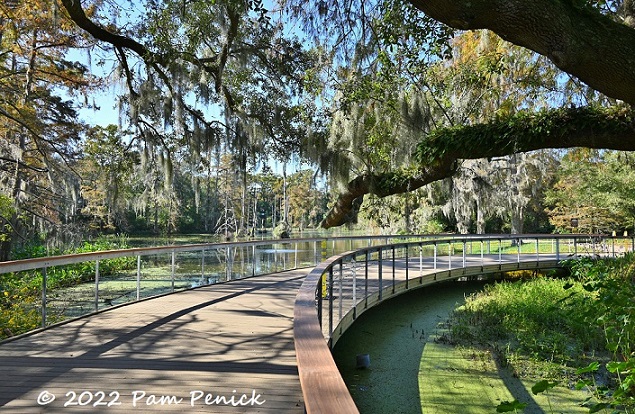
Behind the lily ponds, a curved boardwalk arcs over Ruby Lake, where thousands of resident and migratory birds take up residence throughout the year.
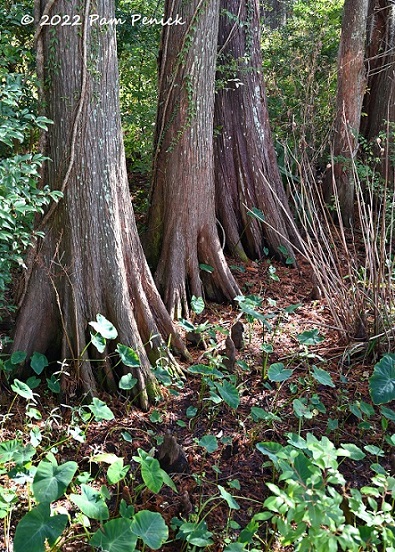
Bald cypress anchors itself in the marshy soil with flared buttresses.
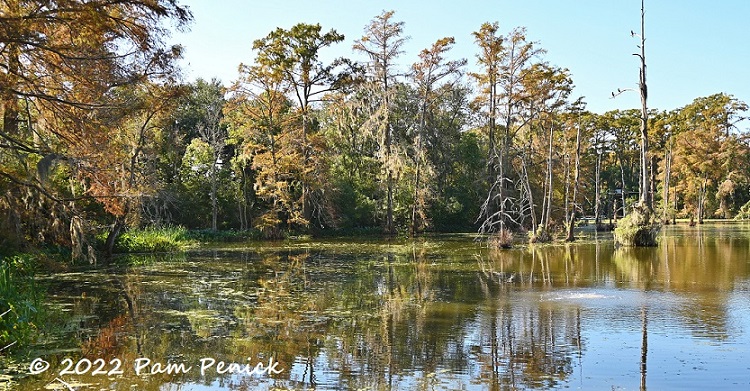
We spotted anhingas and cormorants drying their wings on a snag in the lake.
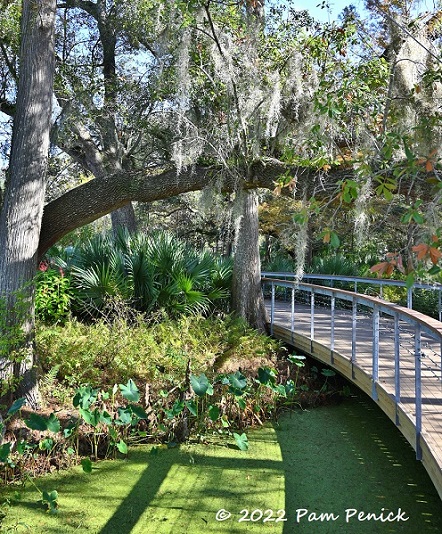
Trailing Spanish moss in the live oaks adds a certain romance to the watery scene. Stark would be pleased, I think.
Up next: Part 2 of my visit to Shangri La, including perennial gardens, the bird blind, an alligator, and the Pond of the Blue Moon. For a look back at our visit to the National Memorial for Peace and Justice in Montgomery, Alabama, click here.
__________________________
Digging Deeper
Come learn about gardening and design at Garden Spark! I organize in-person talks by inspiring designers, landscape architects, authors, and gardeners a few times a year in Austin. These are limited-attendance events that sell out quickly, so join the Garden Spark email list to be notified in advance; simply click this link and ask to be added. Season 8 kicks off in fall 2024. Stay tuned for more info!
All material © 2025 by Pam Penick for Digging. Unauthorized reproduction prohibited.


Malvaviscus penduliflorus does indeed grow here! It has a tendency to flop if it isn’t cut back a few times during the growing season. I think I got mine at Barton Springs Nursery.
I’m glad to know that! Thanks, Lori.
Great photography as usual, Pam. About M. penduliflorus: I have it in my Dallas garden, but here it doesn’t start blooming until November. Right now mine has several flowers, but the freeze next week will end that. The plant is quite tough, dying to the ground after the superfreeze of 2021 but coming back like a champion.
Wow, November is pretty late for a Turk’s cap, although I think my ‘Big Momma’ didn’t start blooming until November this year. Thanks for sharing your experience with it, Peter.
My Big Mama turk’s cap has been blooming like crazy since October. The coming freeze will end that too.
I’m surprised at how much I love that grouping of the 3 bottle trees. All your photos are splendid as usual, Pam, but I was particularly taken with those of the Ruby Lake area.
Thanks, Kris. The bottle trees are quite striking and fun.
Great post, thanks for sharing. I had never heard of this place and now I want to visit it. Their resilience is amazing and inspiring. I had minimal damage in the snowpocalypse two years ago and I’m still whining about it. To start over three times – wow!
I’m still whining about Snowpocalypse too, Paula – ha! Yes, their resilience and determination is impressive.
Oh Pam, this is a particularly poignant post for me, and I really appreciate you sharing your visit. I spent the first 18 years of my life in Orange, with frequent return visits until my parents both passed away. My amazing 7th grade science teacher, a man I credit with solidifying my love of biology, birds, and nature in general, was the first director of Shangri La when they began working towards refurbishment in the early 2000’s. I haven’t visited since he gave my mom and me a private tour, probably in 2003 before they officially opened to the public. It has changed so much! I look forward to seeing part 2 of your post, and will have to make my way back and see it for myself. Thank you.
How cool to have learned about science from the first director of the garden! I bet any kid growing up in Orange is inspired by these gardens and natural areas. Thanks for your comment, Maggie.
those are the best bottle trees I’ve ever seen!
They’re wonderful — times 4!
What a treasure of a garden to visit – the ponds and that last curved bridge into bayou goodness! I can’t imagine why one snow or bad freeze would send a garden into disrepair or neglect 50+ years, as extremes are part of climate and gardens, farms, etc. outdoors. But I also can imagine why regional visionaries were hired to make this garden better than ever. This would easily join a couple other Gulf Coast gardens further east I’ve enjoyed.
I’d love to hear which ones, David. I’m always looking for new gardens to visit!